Jan 13, 2011
Hansen Unhinged: US Democracy Not Competent, Calls on Communist China to “Save Humanity”
Haunting the Library
UPDATE: See Pat Michaels discussion of Hansen’s efforts in this new Washington Post article.
The NASA scientist at the heart of the global warming fiasco seems set to stir more controversy after declaring in an op ed piece for The South China Morning Post and a personally published follow-up that American democracy is not competent to deal with global warming, and communist China now represents the world’s “best hope”.
In the op ed piece for the Chinese newspaper, which he entitled Chinese Leadership Needed to Save Humanity (published as The Price of Change) Hansen placed the blame for the vast majority of Co2 emissions supposedly causing global warming on his home country of America, and appealed to China not to follow the same path. Hansen said that China was the world’s “best hope” and called for them to “lead the world through the most dangerous crisis that humanity and nature have ever faced”.
In a follow-up article published on his website Hansen calls Americans “barbarians” and slams American democracy, calling for China to raise tariffs on American-made products until such time as America falls into line.
He recalls with some bitterness how the findings on fuel efficiency that he and his “A-Team” (as he calls it) of crack scientists came up with were held up for years by the democratic and judicial process in the United States:
We “won” the court case, yet appeals stretched the time of action for years. I came away feeling that not only is it nearly impossible to get effective legislation through Congress, but that the special interests can prevent implementation almost interminably. Democracy of the sort intended in 1776 probably could have dealt with climate change, but not the fossil-money - ‘democracy’ that now rules the roost in Washington.

James Hansen, China and the Barbarians.
The declaration that American ‘democracy’ (as he sarcastically refers to it as) cannot cope with climate change, and that the world must look to the Chinese communist dictatorship to “lead” is bound to be controversial.
What is potentially even more controversial is that Hansen goes on to condemn the current democratic system in America as “dysfunctional” as it will not enact the carbon taxes he has been calling for. All is not lost, though, as he advises the Chinese government what to do about Congress in a truly incredible passage in his letter:
However, there is a way around that, which becomes obvious with the realization that an initially modest carbon fee is in China’s own interest. After agreement with other nations, e.g., the European Union, China and these nations could impose rising internal carbon fees. Existing rules of the World Trade Organization would allow collection of a rising border duty on products from all nations that do not have an equivalent internal carbon fee or tax.
The United States then would be forced to make a choice. It could either address its fossil fuel addiction with a rising carbon fee and supportive national investment policies or it could accept continual descent into second-rate and third-rate economic well-being.
My reading of this is that Hansen is advising a foreign, communist dictatorship how to circumvent American democracy and “force” (his word) America into either kow-towing over carbon taxes, or “accepting continual descent”. It is truly breath-taking that a federal employee seems able to get away with such seemingly unpatriotic activity without any reprimand or disciplinary action.
Hansen concludes his remarkable personal advice by expressing his hope that China will be able to find “good barbarians” (i.e. compliant Westerners) to help it “participate in effective policy”. As he observes, the great thing about China is that they are not bound by the inconveniences of democracy, such as elections and accountability and can simply impose decisions by diktat:
I have the impression that Chinese leadership takes a long view, perhaps because of the long history of their culture, in contrast to the West with its short election cycles. At the same time China has the capacity to implement policy decisions rapidly.
Hansen also claimed that if no action was taken, and all fossil fuels were burnt, then sea levels would rise by 75 metres (246 feet).
Read more here.
See the excellent critique of the Hansen and IPCC model forecasts here in ALARMING WARMING? Reality Trumps Dire Predictions here
Jan 12, 2011
December Update - Current USA Cooling Trend and Why It Should be Lights Out for Alarmism
By SBVOR
71 Year USA Cooling Trend for December.
Click here to enlarge it.
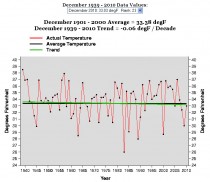
23 Winters with NO WARMING! Will this be winter number 24?
Click here to enlarge it.
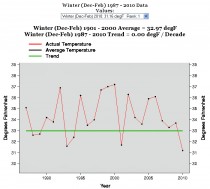
12 Winters of RAPID COOLING! )(31.5F/century!) Will this be winter number 13?
Click here to enlarge it.
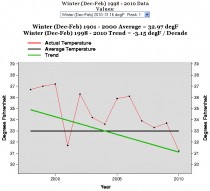
12 Years of Annualized RAPID COOLING!
Click here to enlarge it.
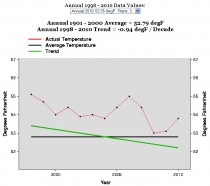
Please! Tell me again who thinks it is a good idea to utterly waste $45 TRILLION in order to pretend we can micromanage climate change. Kyoto has already PROVEN that we can waste all the money we want and we will not even come CLOSE to changing the global temperature in any way which could even be measured.
Furthermore, history tells us that the estimate of $45 TRILLION would balloon into at LEAST a full order of magnitude above that figure.
See the post here. See similar post here.
---------
Phil Jones Proves ALL IPCC Computer Models are WRONG!
Quoting the U.K. Mail Online: “[Phil Jones, of ClimateGate infamy] said that for the past 15 years there has been no ‘statistically significant’ warming”. He also noted the globe had cooled 0.12C (0.22F) from 2002 to 2009.
Click here for the BBC Q&A.
The most overwhelming significance of this admission has been overlooked by EVERYBODY!
The alarmists at NOAA are on record admitting that: “The [computer model] simulations rule out (at the 95% level) zero trends [in global temperatures] for intervals of 15 yr or more, suggesting that an observed absence of warming of this duration is needed to create a discrepancy with the expected present-day warming rate.”
That’s it! Game OVER! The AGW Hysteria cult is officially DEAD and BURIED!
According to the very core of the alarmist cabal, the IPCC computer models—the SOLE SOURCE of all the hysterical predictions of climate catastrophe—have been invalidated!
----------
Yet after scurrying during recent cooling to find more warmth by eliminating UHI adjustments for the US (NOAA) and pretending bad siting did not matter (soon to be shown not to be the case) and NASA pretending it had superior arctic data and taking advantage of record blocking to extrapolate record warm all across the arctic (although Norway on the edge of the arctic had the coldest year since 1941), NOAA and NASA predictably announce 2010 was tied for the warmest year. As David Evans notes “They are cheating”.

Enlarged here
Predictably, dumb and dumber here reacted to proclaim its a wake-up call to move forward on the green (really red) cap and tax agenda. NOAA and NASA benefited from their advocacy efforts by getting a huge boost to $438M for 2011 for more global warming research (not including their shares from $600M from the 2009 Recovery Act).
“The prospect of domination of the nation’s scholars by Federal employment, project allocations, and the power of money is ever present - and is gravely to be regarded.” Dwight Eisenhower 1961 Farwell Address to the Nation has indeed proven prescient.
Jan 10, 2011
Customers face huge bill for wind farms that don’t work in the cold
By Tom Mcghie
The failure of Britain’s wind farms to produce electricity in the extreme cold will cost billions of pounds, create an economic crisis and lead to blackouts, leading industrialists have warned.
To cover up the ineffectiveness of wind farms the Government will be forced to build emergency back-up power plants, the cost of which will be paid by industry and consumers.
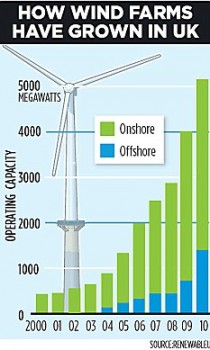
Enlarged here.
Jeremy Nicholson, director of the Energy Intensive Users Group, which represents major companies employing hundreds of thousands of workers in the steel, glass, pottery, paper and chemical industries, said the failure of wind power had profound implications.
Flawed: To cover up the ineffectiveness of wind farms the Government will be forced to build emergency back-up power plants, the cost of which will be paid by industry and consumers. He was speaking after new figures showed that during the latest cold snap wind turbines produced less than two per cent of the nation’s electricity.
Now Mr Nicholson predicts that the Government will encourage power companies to build billions of pounds worth of standby power stations in case of further prolonged wind failures.Last updated at 1:20 AM on 9th January 2011
And the cost of the standby generation will be paid for by industry and households through higher bills - which could double by 2020. Industry regulator Ofgem has already calculated that the cost of achieving sustainable energy targets - set by Brussels but backed by the British Government - will amount to 200 billion pounds, which will mean that annual household fuel bills will double to about 2,400 pounds on average within the next ten years.
In the last quarter ending December 23, wind turbines produced on average 8.6 per cent of our electricity, but the moment the latest bad weather arrived with snow and freezing temperatures, this figure fell to as low as 1.8 per cent.
The slack was immediately taken up by efficient, but dirty, coal-fired power stations and oil-fired plants. ‘What is so worrying is that these sort of figures are not a one off,’ said Mr Nicholson. ‘It was exactly the same last January and February when high pressure brought freezing cold temperatures, snow and no wind.’
In fact last year, the failure of wind power to produce electricity was even more profound. Then, over a few days, the lack of wind meant that only 0.2 per cent of a possible five per cent of the UK’s energy was generated by wind turbines. So little energy was generated then that the National Grid, which is responsible for balancing supply and demand of energy in the UK, was forced to ask its biggest users - industry - to ration supplies.
What really concerns industrial users is that it is Government policy to put wind power at the centre of its efforts to ensure that 30 per cent of electricity is generated by renewable resources by 2020. This means that the number of turbines now running - 3,140 - will have to be massively increased to well over 6,000 in ten years time.
But this huge surge in wind farm activity will come at the same time as an EU Directive will insist that we close down our coal-fired and oil-fired power stations. Mr Nicholson said: ‘We can cope at the moment because there is still not that much power generated from wind. But all this will change. What happens when we are dependent on wind turbines for 30 per cent of our power and there is suddenly a period when the wind does not blow and there is high demand?
‘We will be forced to switch off the gas and it could even lead to power cuts.’ The Government is aware of the dangers of relying on intermittent power sources and is working on plans to encourage energy companies through financial inducements to have stand-by generation.
Mr Nicholson said: ‘At least the Government is aware of the problem, but it will cost billions to put these measures in place and we will have to pick up the tab. A Department of Energy and Climate Change spokesman said: ‘Wind power provides a home-grown source of electricity that doesn’t produce carbon dioxide. The electricity system always has more generating capacity available than the expected demand. By having a diverse energy mix, we can manage the fact that some technologies are intermittent.’
The National Grid is also aware of the problem and has set up a team to look at solving the problem of erratic energy supplies. One of the solutions being considered is changing demand at times of crisis. For example, setting up systems to stop electricity supplies to millions of fridges for an hour or so. This would be possible by having ‘smart’ meters and would save massive amounts of energy.
Read post here.
In Maine, one wind turbine is delivering just 1/10th of the promised output. The wind company told the town they need to move it to a better location....and so need more money. The town will be throwing good money after bad. They should sue not reward the wind company.
--------
Coal takes the strain...again
By Paul Hudson, BBC
On BBC Look North on friday I reported that during the recent intense cold weather, it’s been our traditional coal and gas fired power stations that have been working flat out to keep our homes and businesses warm.
And for the third winter running, the intense cold has gone hand in hand with periods of little or no wind. This should come as no surprise since prolonged cold is invariably associated with areas of high pressure.
Peak demand also comes during summer heat waves - as we all turn on our air conditioning units - again usually associated with areas of high pressure, with little or no wind.
December 21st 2010 was one of the coldest days on record in Yorkshire. The bar chart below gives an idea of how much electricity was being generated by which type of power facility, when temperatures were at their lowest.
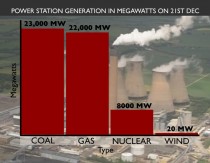
Enlarged here.
With much of the country experiencing very little wind, both onshore and offshore, wind turbines were largely inactive.
At the moment that is not a problem. Only 5% of electricity is currently generated by wind farms, and so other power stations can step in and ramp up output.
But in only 9 years time, the UK will legally have to generate around 30% of its electricity from renewable sources, of which 25% is expected to come from wind farms alone, as it is seen as a clean, carbon free energy source.
So what will happen then, when the wind doesn’t blow?
If a similar meteorological situation occurred in 2020, then almost 25% of power would have to come from sources other than wind.
This means that there would have to be some power stations - using coal or gas, since nuclear power output can’t be increased at short notice - that simply exist as a stand-by facility, in case the wind doesn’t blow.
And that’s a very expensive way of producing electricity.
And what happens if, as seems at least possible, the next 10-15 years sees an increase in the type of disrupted weather patterns that we have experienced recently, because of solar considerations?
Professor Mike Lockwood at Reading University thinks that the UK could indeed experience colder winters on average, compared with the last few decades because of the sun’s low activity.
This would lead to a higher frequency of ‘blocking’ weather patterns leading to less frequent windy conditions than would normally be expected if one looks at climatological averages - suggesting we would have to continue to rely on coal and gas fired power generation well into the future - and possibly more than is currently envisaged. Read more here.
Jan 09, 2011
“2010 was the Warmest Year on Record”
By Christopher Monckton of Brenchley on SPPI
Michael Steketee, writing in The Australian in January 2011, echoed the BBC (whose journalists’ pension fund is heavily weighted towards “green” “investments") and other climate-extremist vested interests in claiming that 2010 was the warmest year on record worldwide. Mr. Steketee’s short article makes two dozen questionable assertions, which either require heavy qualification or are downright false. His assertions will be printed in bold face: the truth will appear in Roman face.
1. BASED ON PRELIMINARY DATA TO NOVEMBER 30, SEA SURFACE TEMPERATURES AROUND AUSTRALIA WERE THE WARMEST ON RECORD LAST YEAR, AS WERE THOSE FOR THE PAST DECADE.
The record only began ten decades ago. As for sea temperatures, they are less significant for analyzing “global warming” than estimated total ocean heat content. A recent paper by Professors David Douglass and Robert Knox of Rochester University, New York, has established that - contrary to various climate-extremist assertions - there has been no net accumulation of “missing energy” in the form of heat in the oceans worldwide in the six years since ocean heat content was first reliably measured by the 3000 automated ARGO bathythermographs in 2003. This finding implies that the amount of warming we can expect from even quite a large increase in CO2 concentration is far less than the IPCC and other climate-extremist groups maintain.
2. THE WORLD METEOROLOGICAL ORGANISATION SAYS THE YEAR TO THE END OF OCTOBER WAS THE WARMEST SINCE INSTRUMENTAL CLIMATE RECORDS STARTED IN 1850 - 0.55 C ABOVE THE 1961-90 AVERAGE OF 14 C.
It is easy to cherry-pick periods of less than a calendar year and say they establish a new record. The cherry-picking of the first nine months of 2010 is particularly unacceptable, since that period was dominated by a substantial El Nino Southern Oscillation, a sudden alteration in the pattern of ocean currents worldwide that leads to warmer weather for several months all round the world. The last few months of the year, carefully excluded from Mr. Steketee’s statement, showed the beginnings of a La Nina event, which tends largely to reverse the effect of its preceding El Nino and make the world cooler. Indeed, the calendar year from January to December 2010, according to the reliable RSS and UAH satellite records, was not the warmest on record. Besides, what is important is how fast the world is warming. In fact, the rate of warming from 1975-2001, at 0.16 C per decade, was the fastest rate to be sustained for more than a decade in the 160-year record, but exactly the same rate occurred from 1860-1880 and again from 1910-1940, when we could not possibly have had anything to do with it. Since late 2001 there has been virtually no “global warming” at all.
3. THE LAST DECADE ALSO WAS THE WARMEST ON RECORD.
After 300 years of global warming, during nearly all of which we could not on any view have influenced the climate to a measurable degree, it is scarcely surprising that recent decades will be warmer than earlier decades. That is what one would expect. If one has been climbing up a steep hill for a long time, one should not be surprised to find oneself higher up at the end of the climb than at the beginning.
4. THE WORLD IS NOT COOLER COMPARED TO 1998.
Actually, it is cooler. There was a remarkable spike in global temperatures in 1998, caused not by manmade “global warming” but by a Great El Nino event - an alteration in the pattern of ocean currents that begins in the equatorial eastern Pacific and spreads around the globe, lasting a few months. In the first nine months of 2010 there was another substantial El Nino, but even at its peak it did not match the Great El Nino of 1998.
5. THE TRENDS HAPPEN TO FOLLOW CLOSELY THE PREDICTIONS OVER THE PAST 40 YEARS OF TEMPERATURE RISES RESULTING FROM INCREASED GREENHOUSE GAS EMISSIONS.
In the 40 years since 1970, global temperatures have risen at a linear rate equivalent to around 1.3 C/century. CO2 concentration is rising in a straight line at just 2 ppmv/year at present and, even if it were to accelerate to an exponential rate of increase, the corresponding temperature increase would be expected to rise merely in a straight line. On any view, 1.3 C of further “global warming” this century would be harmless. The IPCC is predicting 3.4 C, but since the turn of the millennium on 1 January 2001 global temperature has risen (taking the average of the two satellite datasets) at a rate equivalent to just 0.6 C/century, rather less than the warming rate of the entire 20th century. In these numbers, there is nothing whatever to worry about - except the tendency of some journalists to conceal them.
6. MOST SCIENTISTS AGREE THAT DOUBLING THE CARBON DIOXIDE IN THE ATMOSPHERE IS LIKELY TO LEAD TO WARMING OF 2-3 C.
It is doubtful whether Mr. Steketee had consulted “most scientists”. Most scientists, not being climate scientists, rightly take no view on the climate debate. Most climate scientists have not studied the question of how much warming a given increase in CO2 concentration will cause: therefore, whatever opinion they may have is not much more valuable than that of a layman. Most of the few dozen scientists worldwide whom Prof. Richard Lindzen of MIT estimates have actually studied climate sensitivity to the point of publication in a learned journal have reached their results not by measurement and observation but by mere modeling. The models predict warming in the range mentioned by Mr. Steketee, but at numerous crucial points the models are known to reflect the climate inaccurately. In particular, the models predict that if and only if Man is the cause of warming, the tropical upper air, six miles above the ground, should warm up to thrice as fast as the surface, but this tropical upper-troposphere “hot-spot” has not been observed in 50 years of measurement by balloon-mounted radiosondes, sondes dropped from high-flying aircraft, or satellites. Also, the models predict that every Celsius degree of warming should increase evaporation from the Earth’s surface by 1-3%, but the observed increase is more like 6%. From this it is simple to calculate that the IPCC has overestimated fourfold the amount of warming we can expect from adding greenhouse gases to the atmosphere. Take away that prodigious exaggeration, demonstrated repeatedly in scientific papers but never reported by the likes of Mr. Steketee, and the climate “crisis” vanishes.
Read the rest of Chris’s rebuttal here.
Jan 08, 2011
How can climate scientists spend so much money?
Climate Quotes
ICECAP NOTE: One of the certain brain-dead, knee-jerk reactions in comments to any posted article with any semblence of balance or skepticism on greenhouse global warming is that “big oil” must be funding the author or the skeptics. Nothing could be further from the truth. Exxon was accused of funding alternative thinking on climate change to the tune of $22 million the last few decades (most of the before 2000). No mention that Exxon gave $100million to Stanford and BP $500 million to the University of California Berkeley. Exxon and most big oil companies have gone green. There is also no recognition that the government funds climate change research - read global warming - to the tune of $2.3 billion to further their social agenda as this excellent expose shows below. That is a place for the congress to look to save money. The remaining research sollars should be to study climate change not global warming because there is a very real possibility that due to the sun and oceans, a major global cooling could take place and very little research dollars focus on this.
How can climate scientists spend so much money?
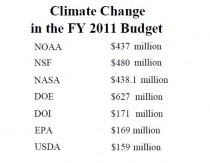
US Federal government spending on climate change research in 2011 (enlarged here).
Until a few days ago I knew that the US government spent an excessive amount of taxpayer money on climate change research. It was just a general notion; I had read occasional articles showing the funding of certain agencies like NASA but I didn’t know many specifics. Then on New Years Day, I wrote a very quick article where I randomly picked a document from a Google search showing funding for climate change. The numbers astonished me. I decided to take a closer look.
The document is the The American Association for the Advancement of Science’s report: AAAS REPORT XXXV, RESEARCH AND DEVELOPMENT FY 2011
The entire report is here, but I am only looking at chapter 15 which is here. Icecap Note: See how the AMS has authored this chapter. The report is basically a snapshot of US Federal spending on research, including budgets for 2011 and how these numbers compare to previous years. The chapter on climate change is short and easy to read. It shows that all US agencies that conduct climate change research are expected to have larger budgets for 2011. Remember, these numbers are not set in stone, but they will not be drastically different from the actual numbers. I also need to make a caveat. Just because this funding has been labeled ‘climate change research’ does not mean it is necessarily not linked to another field as well. For example, some of the costs associated are for satellites, which are important in more than just climate research. This is not entirely frivolous spending. Even so, the numbers are staggering. Let’s look at some agencies and their budgets.
National Oceanic and Atmospheric Administration (NOAA).
NOAA’s total budget request is $5.6 billion, which would be an increase of 17.0 percent. Of this, $437 million would be for climate research funding, which is an increase of $77 million.
$437 million spent on climate change research in one year, in one agency. Here’s another:
National Science Foundation (NSF). NSF would receive $7.4 billion in FY 2011, an increase of 8 percent relative to the FY 2010 appropriation. The request includes $370 million under the USGCRP framework, which is an increase of 16.0 percent. The Geosciences Directorate would receive $955 million (a 7.4 percent increase) in FY 2011 with $480 million going to Atmospheric and Earth Sciences. NSF’s Science, Engineering, and Education for Sustainability (SEES) program would receive $765.5 million. This is intended to promote discoveries and capability needed to inform societal actions in ways that contribute to environmental and economic sustainability. NSF’s request also includes $19 million for RE-ENERGYSE, a joint program with the Department of Energy intended to promote education in clean energy research. An additional $10 million would fund Climate Change Education, which seeks to increase understanding of climate among the next generation of Americans.
$480 million here, $765.5 million there, throw in another $10 million for climate education and you’ve got $1.25 billion dollars spent on climate change research just at the NSF, just in ONE YEAR! Next is NASA:
National Aeronautics and Space Administration (NASA). NASA’s FY 2011 budget request is $19.0 billion. NASA Earth Science is a relatively small fraction of this total, $1.8 billion or 9.5 percent, but would increase substantially relative to the FY 2010 appropriation (up 26.8 percent). NASA Earth Science funds climate change R&D through several programs. Two of particular note are Earth Science Research, which would receive $438.1 million (an increase of 14 percent)…
It seems like the $450 million mark is a common budget for climate research among these agencies. NOAA’s funding, the NSF’s atmospheric science funding, and NASA’s Earth Science research are all around $450 million. It may be an interesting coincidence. Next is the Department of Energy:
Department of Energy (DOE).
The President’s budget request for DOE in FY 2011 is $28.4 billion. This includes $4.6 billion for R&D in the Office of Science (an increase of 3.8 percent), and $2.4 billion for energy R&D (an increase of 6.8 percent). Within the Office of Science, the Office of Biological and Environmental Research (BER), which supports basic research in atmospheric sciences, terrestrial ecosystems and climate modeling, would receive $627 million (an increase of 3.8 percent). BER’s request includes $28.6 million for the Terrestrial Ecosystem Science (TES) program, which examines the impact of climate change on biological systems and land-surface carbon cycle feedbacks to climate change.
$627 million taken from a taxpayer or borrowed from a future taxpayer, spent in one year. Next the Department of the Interior:
Department of the Interior (DOI).
DOI requests $171 million (an increase of 26.0 percent) for its Climate Change Adaptation initiative, which seeks to identify areas and species most vulnerable to climate change and implement coping strategies. Of this, the United States Geological Survey (USGS) would receive $77.9 million for climate science (an increase of 15.5 percent).
How many jobs could be created in 2011 if $171 million were still in the hands of US taxpayers, instead of being spent on climate studies which have been done many times before? Studying areas vulnerable to climate change? That’s already been done by every agency, twice. Next is the EPA:
Environmental Protection Agency (EPA).
EPA requests $169 million to reduce greenhouse gas emissions (an increase of 1 percent). Of this, $43.5 million is new funding for regulatory efforts to reduce greenhouse gas emissions through the Clean Air Act. EPA requests $22 million for its Global Change Research Program, which assesses the impacts of global change on air and water quality, ecosystems, human health, and socioeconomic systems in the United States with a primary goal of promoting adaptation efforts.
I don’t even understand what this means. How does giving the EPA $169 million reduce emissions? Also, does it really cost $43.5 million a year (more) to regulate greenhouse gases? Lastly, the USDA:
U.S. Department of Agriculture (USDA).
USDA requests $159 million for climate change research, an increase of 42.0 percent, and $179 million for renewable energy, an increase of 41.0 percent. USDA’s climate change efforts (and those of the U.S. Forest Service which is part of USDA) center on helping farmers and land owners adapt to climate change impacts (e.g., enhanced fire stress, insect outbreaks, droughts, floods, and heat stress) and promoting carbon storage in soils and forests.
A 42% increase in climate change research? $159 million spent in a single year, by the USDA? Crop yields are up! CO2 helps crops! Imagine spending $159 million in 2011 to research things that actually help people.
The amount of money being spent on climate change research this year is astounding. I urge you to read the document yourself. Here is the question to take away: what are we getting for the billions of dollars we’ve spent? When 2011 is over will we look back at the published research and be satisfied with how our billions have been spent? This type of spending has occurred for some time, and what do we have to show for it? Multiple federal agencies having multi-hundred million dollar budgets in the same (controversial) field is wasteful. Let’s make sure 2011 is the last year these budgets increase.
See the analysis here.
|











